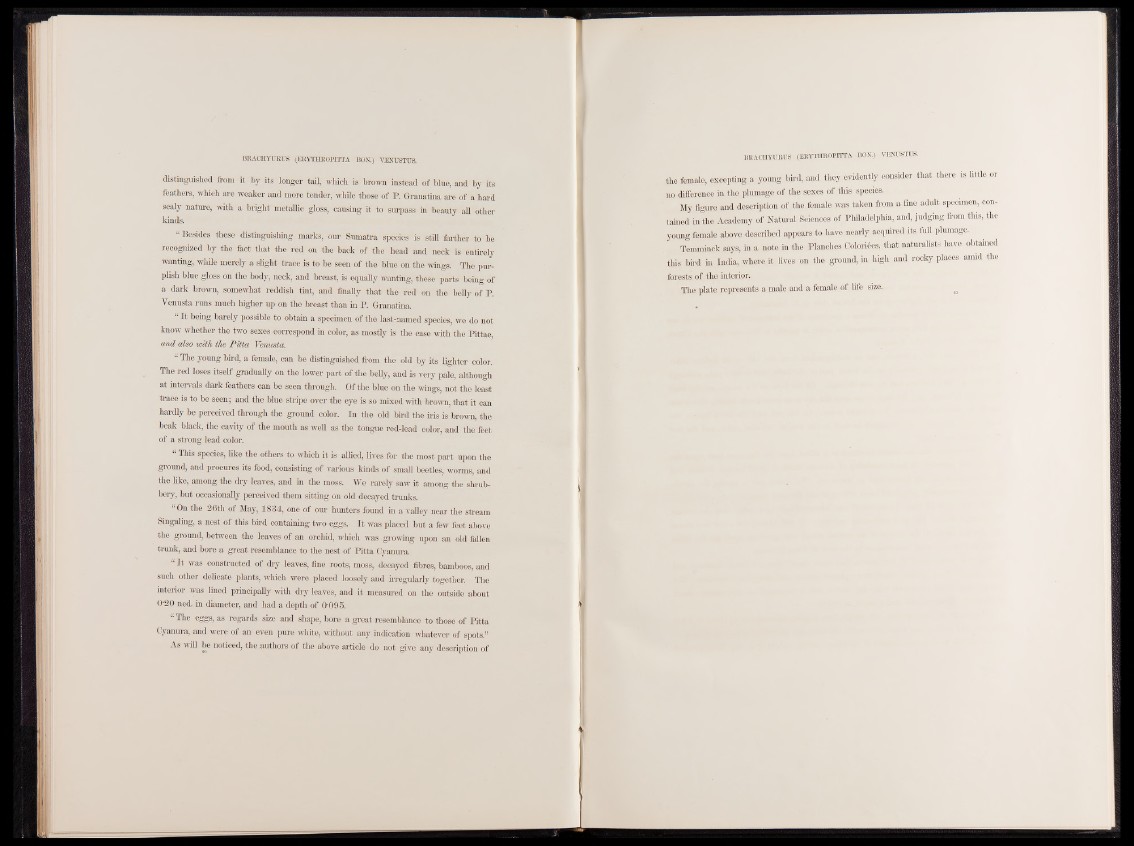
distinguished from it by its longer tail, which is brown instead of blue, and by its
feathers, which are weaker and more tender, while those of P. G-ranatina are of a hard
scaly nature, with a bright metallic gloss, causing it to surpass in beauty all other
kinds.
U Besides these distinguishing marks, our Sumatra species is still farther to be
recognized by the fact that the red. on the back of the head and neck is entirely
wanting, while merely a slight trace is to be seen of the blue on the wings. The purplish
blue gloss on the body, neck, and breast, is equally wanting, these parts being of
a dark brown, somewhat reddish tint, and finally that the red on the belly of P.
Venusta runs much higher up on the breast than in P. Granatina.
“ It being barely possible to obtain a specimen of the last-named species, we do not
know whether the two sexes correspond in color, as mostly is the case with the Pittae
and also with the Pitta Venusta.
“ The young bird, a female, can be distinguished from the old by its lighter color.
The red loses itself gradually on the lower part of the belly, and is very pale, although
at intervals dark feathers can be seen through. Of the blue on the wings, not the least
trace is to be seen; and the blue stripe over the eye is so mixed with brown, that it can
hardly be perceived through the ground color. In the old bird the iris is brown, the
beak black, the cavity of the mouth as well as the tongue red-lead color, and the feet
of a strong lead color.
This species, like the others to which it is allied, lives for the most part upon the
ground, and procures its food, consisting of various kinds of small beetles, worms, and
the like, among the dry leaves, and in the moss. We rarely saw it among the shrubbery,
but occasionally perceived them sitting on old decayed trunks.
“On the 26th of May, 1834, one of our hunters found in a valley near the stream
Singaling, a nest of this bird containing two eggs. It was placed but a few feet above
the ground, between the leaves o f an orchid, which was growing upon an old fallen
trunk, and bore a great resemblance to the nest of Pitta Cyanura.
“ It was constructed of dry leaves, fine roots, moss, decayed fibres, bamboos, and
such other delicate plants, which were placed loosely and irregularly together. The
interior was lined principally with dry leaves, and it measured on the outside about
0'20 ned. in diameter, and had a depth of 0-095.
eSSsj regards size and shape, bore a great resemblance to those of Pitta
Cyanura, and were of an even pure white, without any indication whatever of spots.”
As will be noticed, the_authors of the above article do not give any description of
the female, excepting a young bird, and they evidently consider that there is little or
no difference in the plumage of the sexes of this species.
My figure and description of the female was taken from a fine adult specimen, contained
in the Academy of Natural Sciences of Philadelphia, and, judging from this, the
young female above described appears to have nearly acquired its frill plumage.
Temminck says, in a note in the Planches Coloriées, that naturalists have obtained
this bird in India, where it lives on the ground, in high and rocky places amid the
forests of the interior.
The plate represents a male and a female of life size. o